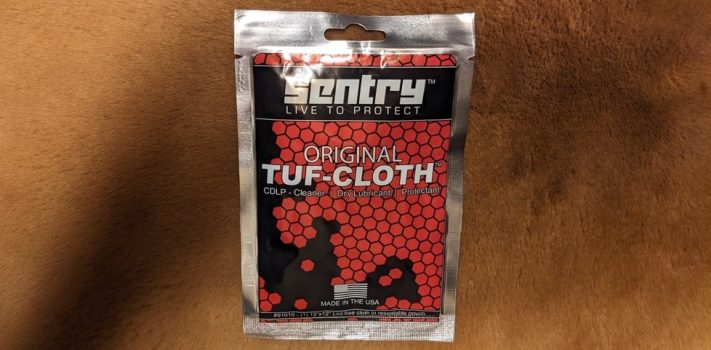Sentry Tuf-Cloth provides a conveniently-packaged, non-toxic, lint-free cloth for cleaning, lubricating, and protecting cutlery, firearms, tools, and other metal objects.
It is made in the USA, and is available in vapor barrier foil pouches or in plastic jars in either a standard version or in a marine version that is designed for more corrosive environments. The Tuf-Glide CDLP (clean, dry-lube, protectant) solutions that impregnate the cloth are also available without the cloth in pen applicators or in spray bottles of various sizes.
At the time of this writing, the standard and marine Tuf-Cloths in the foil pouch were priced at $11.99 from www.sentrytactical.com . The standard Tuf-Cloth in a jar was also priced at $11.99, with the marine version in the jar being priced at $12.99.
After testing the standard version in the foil pouch and the marine solution in an 8 ounce spray bottle, I would recommend either product for cutlery such as hunting knives or EDC knives which may occasionally come into contact with food. I do not recommend the products for firearms or for other items that need significant protection from corrosion or for cutlery that comes into regular daily contact with food. Under extremely dry and dusty conditions, Tuf-Cloth may provide superior lubrication performance in comparison with oils that may attract grit. My testing did not include the aforementioned dry and dusty conditions.
Background
I recently tested an L.T. Wright Large Northern Hunter belt knife. Mr. Wright recommends keeping a thin coat of oil on the knife using a Sentry Solutions Tuf-Cloth or Ballistol Sportsman’s Oil.
I was not familiar with the Sentry Tuf-Cloth, so I contacted Sentry Products Group to see if they could provide me with a sample for testing and evaluation. Less than a week later, a package with the sample arrived via USPS.
First Impressions
The Tuf-Cloth sample that I received is the version that comes in a re-sealable vapor barrier foil pouch. The pouch contains a 12 x 12 inch, lint-free cloth that is impregnated with the Tuf-Glide CDLP solution.
I was happy to see an American flag and the words “Made in the USA” on the outside of the pouch.
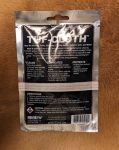 The pouch declares that the Tuf-Cloth is “Ideal for knives, Tools, Firearms, Fishing Tackle, Outdoor Gear, and More!” It also indicates that the product, “Goes on wet, leaving behind a micro bonded barrier when dry . . . .” It further indicates that it contains a solvent that removes dirt and oils, and that the dry lubricant helps to prevent the adhesion of dirt and other fouling agents to treated items.
The pouch declares that the Tuf-Cloth is “Ideal for knives, Tools, Firearms, Fishing Tackle, Outdoor Gear, and More!” It also indicates that the product, “Goes on wet, leaving behind a micro bonded barrier when dry . . . .” It further indicates that it contains a solvent that removes dirt and oils, and that the dry lubricant helps to prevent the adhesion of dirt and other fouling agents to treated items.
Non-Toxic Versus Food-Safe
The Tuf-Glide CDLP solution that impregnates the Tuf-Cloth is “non-toxic”. This means that it does not contain poisonous substances. “Non-toxic” is not the same as “food-safe”. “Food-safe” means that an object or substance is permitted to come into contact with food. The standards for the manufacture and distribution of food-safe materials are much higher than the standards for non-toxic materials. For example, the manufacturing process for non-toxic materials does not necessarily consider exposure to pathogens like bacteria or viruses. The manufacturing process for food-safe materials is intended to limit such exposure to pathogens.
The risk of a Tuf-Cloth transmitting pathogens is low enough that I would be comfortable using it on a hunting knife that I would use to field dress game, or on an EDC knife that I might use for occasional food preparation in the field. For regular kitchen use, I would recommend the use of food grade mineral oil instead.
For knives like my Cold Steel Leatherneck SF Field Knife that I use for exceptionally rough and dirty projects, and that I never anticipate bringing into contact with food, I will probably continue to utilize used motor oil as my protectant of choice. Some may point out that used motor oil may be carcinogenic. I would suggest that as long as you don’t consume it or use it as a skin lotion, you will probably be okay (note: I am not a medical professional, and this is not intended as medical advice).
Testing
The directions on the foil pouch for using the Tuf-Cloth are quite clear and straight-forward. The user simply needs to remove the Tuf-Cloth from the pouch, wipe the surfaces that they wish to protect firmly and completely, allow the surface to air dry, and then return the cloth to its vapor barrier pouch and seal it tightly for longer life.
I am actually not impressed with the resealing system on the pouch. It involves folding the opening of the pouch over and fastening it to an adhesive strip. The seal does not appear to be airtight, and online reviewers indicate that if the Tuf-Glide CDLP solution that saturates the Tuf-Cloths comes in contact with the adhesive strip, the adhesive strip will be rendered ineffective. If you are considering purchasing this product, I would recommend buying it in the jar rather than in the foil pouch.
One of the primary characteristics that I value in a protectant is corrosion resistance. I usually use Breakfree CLP as the final step in my firearms cleaning process in order to lubricate and protect those items. I was interested in seeing how the Tuf-Cloth compared with CLP in terms of corrosion resistance.
With that in mind, I went to the scrap metal bucket in my pole barn and selected a rusty drawer slide that was waiting to be recycled. I then used an angle grinder to cut out a section of the slide, nailed that section to a board, sanded the surface of the section to remove the rust, cleaned the surface with kerosene, wiped the extra kerosene away, and allowed the surface to dry.
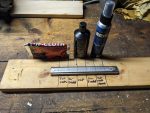 Next, I marked out portions of the surface for the application of various products. I left untreated portions between the marked out portions for each product in order to prevent cross-contamination. I then applied the various products to the pre-designated portions of the surface and allowed those sections to dry. The 3 products that I tested were the Tuf-Cloth, Breakfree CLP, and some Sentry Marine Tuf-Glide CDLP solution that I had purchased for use in this testing. I applied the CLP and the Marine Tuf-Glide using separate and carefully isolated pieces of clean paper toweling.
Next, I marked out portions of the surface for the application of various products. I left untreated portions between the marked out portions for each product in order to prevent cross-contamination. I then applied the various products to the pre-designated portions of the surface and allowed those sections to dry. The 3 products that I tested were the Tuf-Cloth, Breakfree CLP, and some Sentry Marine Tuf-Glide CDLP solution that I had purchased for use in this testing. I applied the CLP and the Marine Tuf-Glide using separate and carefully isolated pieces of clean paper toweling.
After all three portions of the surface were dry, I placed some rock salt in the bottom of a spray bottle, added some water, shook the bottle vigorously, and then heavily sprayed the test surface so that the salt water beaded on all 3 test portions as well as the untreated portions in between those portions. I then set the test surface aside to await developments.
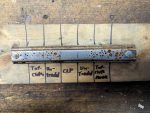
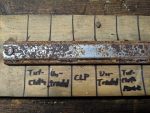 Within less than 24 hours, the Tuf-Cloth and Tuf-Glide portions of the test surface began to show signs of rust, while the CLP portion of the test surface remained corrosion free. Over the course of the ensuing 51 days, the Tuf-Cloth and Tuf-Glide portions of the test surface continued to corrode more and more extensively, while the CLP portion of the test surface remained largely rust free.
Within less than 24 hours, the Tuf-Cloth and Tuf-Glide portions of the test surface began to show signs of rust, while the CLP portion of the test surface remained corrosion free. Over the course of the ensuing 51 days, the Tuf-Cloth and Tuf-Glide portions of the test surface continued to corrode more and more extensively, while the CLP portion of the test surface remained largely rust free.
Based on this testing, I plan to continue to use Breakfree CLP for the final stage of my firearms cleaning process. Since CLP is not non-toxic, I plan to use Tuf-Cloth or Tuf-Glide for my knives that may occasionally come in contact with food. If I need to lubricate any of our kitchen cutlery, I plan to use food grade mineral oil for that purpose.
As a dry lube, Tuf-Cloth may be more effective than CLP under extremely dry and dusty conditions. The dry lube may attract less grit than CLP, while the dry environment will make corrosion resistance a less relevant factor in lubricant selection. But under the damp conditions that I normally encounter in the field, CLP represents a better solution for firearm lubrication and protection for me.
Sentry Products Group
Sentry Products Group produces an extensive line of AR magazines, scope covers, firearm covers, gun cleaning, and lubrication products, plate carriers and vests, belts and pouches, holsters, bags and cases, and other gun accessories.
Sentry Products Group was founded as Scopecoat by former Navy Seal Mike Noell in 2015. After Scopecoat acquired Sentry Solutions (which had been around for about four decades), as well as Slideboot and Hexmag, they were all rebranded under the Sentry Products Group banner.
Conclusions
The Sentry Tuf-Cloth sounded like an interesting product. It promised to clean, lubricate, and protect in one convenient package. The marine version, with extra corrosion resistance sounded especially exciting.
In actual testing, I found good-old-fashioned Breakfree CLP to provide significantly superior corrosion protection. Because it is non-toxic, the Tuf-Cloth would provide more appropriate protection than CLP for items that may occasionally come in contact with food. Because it is not food safe, food safe mineral oil would be more appropriate than the Tuf-Cloth for items that will regularly come in contact with food — such as kitchen cutlery or field butchering saws and cutlery.
For dry and dusty environments where corrosion resistance is less relevant, Tuf-Cloth may provide superior lubrication by not attracting grit like oil-based lubricants tend to do.
Disclaimer
Sentry Products Group was kind enough to provide me with their Tuf-Cloth in a foil pouch for testing and evaluation. L.T. Wright was kind enough to provide me with a sample of his Large Northern Hunter knife for testing and evaluation. Cold Steel had previously provided me with their Leatherneck SF Field Knife for a past review. I tried not to let the kindness of any of these vendors interfere with the objectivity of my review, and I believe that I have succeeded. I did not receive any other financial or other inducement to mention any vendor, product, or service in this article.

